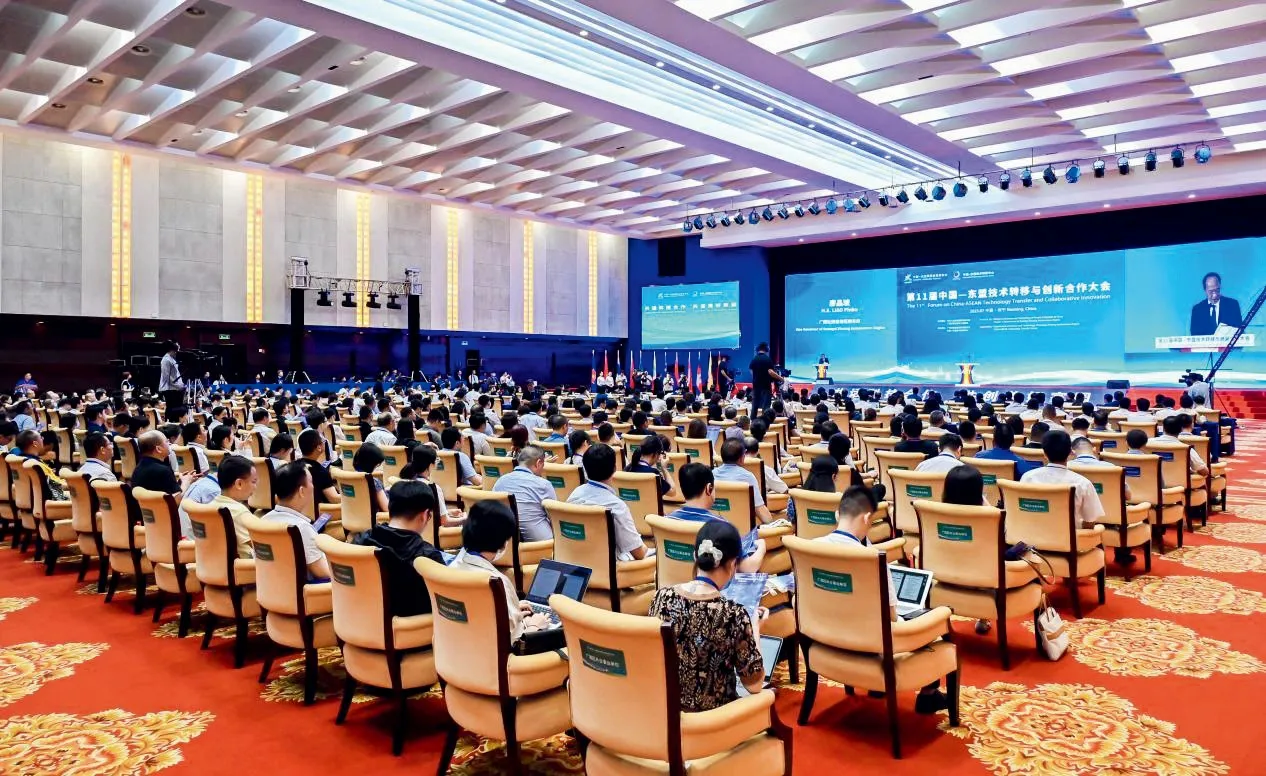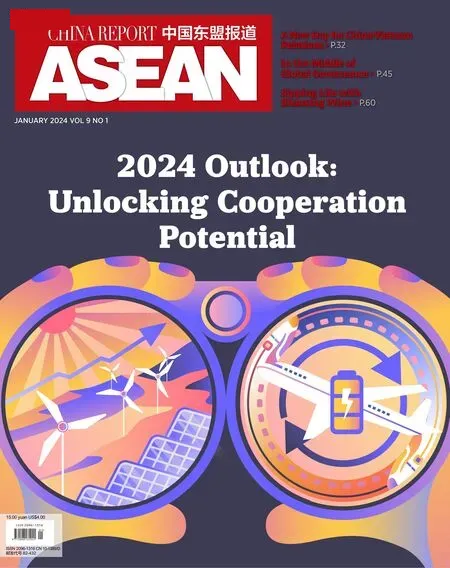China-ASEAN Technological Cooperation
By Gao Yuan
Digital and green technologies remain the focus of cooperation

The Advanced Technology Exhibition at the frist Forum on China-ASEAN Artifciial Intelligence Cooperation held in Nanning,Guangxi Zhuang Autonomous Region,on July 13,2023. (MO WENKUI)
At the 11th Forum on China-ASEAN Technology Transfer and Collaborative Innovation (hereinafter referred to as the China-ASEAN Innovation Forum) in July 2023,ASEAN Secretary-General Kao Kim Hourn highlighted the pivotal role of technology transfer and innovation in driving economic growth.He emphasized that technology transfer can assist China and ASEAN in bypassing traditional developmental stages and creating innovative solutions customized to their unique needs and interests.

Jian Xingchao
Technological innovation has always been a crucial priority in the extensive collaboration between China and ASEAN.In 2023,positive results were achieved as bilateral relations continued to strengthen.The China-ASEAN Technology Transfer Center (CATTC),the only state-level institution in China focused on technology transfer to ASEAN,has played a vital role in this dynamic.CATTC has established intergovernmental working mechanisms for bilateral technology transfer with nine ASEAN countries (excluding Singapore) and developed a collaborative technology transfer network encompassing over 2,800 member institutions across all ten ASEAN countries and several Belt and Road countries.Jian Xingchao,a director of CATTC,recently sat down with China Report ASEAN to discuss the organization’s key initiatives in 2023 and offer insights on future opportunities and challenges.
China Report ASEAN: What new changes and trends emerged in CATTC’s technology transfer to ASEAN in 2023?
Jian Xingchao:We welcomed strong momentum in green technology cooperation.In recent years,CATTC has actively promoted technological cooperation with ASEAN countries in areas such as new energy vehicles,photovoltaic agriculture,and water treatment.As understanding and agreement on ecological protection continue to grow,ASEAN countries have shown increasing interest in collaborating with China to adopt advanced and practical green technologies.China has great expertise in green infrastructure,renewable energy,and sustainable transportation,which foster vast potential and promising prospects for bilateral technology transfer.

The opening ceremony of the 11th Forum on China-ASEAN Technology Transfer and Collaborative Innovation held on July 12,2023. (DEPARTMENT OF SCIENCE AND TECHNOLOGY OF GUANGXI ZHUANG AUTONOMOUS REGION)
Digital technology cooperation has also become a focal point in the region.The Joint Initiative on Advancing the China-ASEAN Science,Technology and Innovation Enhancing Program was adopted at the 26th China-ASEAN Summit in September 2023.It is stated that “China and ASEAN will conduct joint research and develop flagship projects for cross-cultural and interdisciplinary cooperation in areas of common interest such as biology,information,manufacturing,space,ocean,and the environment.We will explore cooperation models for application of new technologies in AI,the digital economy,smart cities,and relevant fields to bridge the digital divide.” In July 2023,CATTC hosted the China-ASEAN Innovation Forum and unveiled the Artificial Intelligence Development Cooperation Initiative for ASEAN,which was warmly welcomed by ASEAN countries.China and ASEAN have great potential for technological cooperation in areas of smart cities,5G,artificial intelligence,e-commerce,big data,blockchain,and telemedicine.
China Report ASEAN: The China-Thailand ASEAN Innovation Hub inaugurated last September is China’s first offshore innovation incubator in an ASEAN country.How will it impact the ASEAN region? What are its future plans?
Jian:The China-Thailand ASEAN Innovation Hub serves as a high-level cooperation platform for scientific and technological innovation and exchange between China and Thailand.It integrates the strengths of CATTC and the Chinese Academy of Sciences Innovation Cooperation Center(Bangkok) and will accelerate the bilateral flow of science and technology innovation resources between China and ASEAN countries through technology transfer activities such as exhibitions,roadshows,project promotions,innovation competitions,and popular science exchange.This will facilitate transformation of accomplishments and benefit the people.The Hub exemplifies the frequent and dynamic interaction in science and technology innovation between China and Thailand.In the future,this will enhance CATTC’s international initiatives and promote exchange and cooperation between the two parties.CATTC will thoroughly review its successful experience and approaches and apply them to practices in other ASEAN countries.
China Report ASEAN: The China-ASEAN Innovation Forum is an important platform for technological innovation and cooperative transfer between China and ASEAN countries.What was distinctive about the 11th forum compared to previous ones?
Jian:Well,this year’s forum was held in person and attended by nine highranking officials from state-level science and technology departments from China,Cambodia,Malaysia,Myanmar,Indonesia,Philippines,and Thailand.In addition to regular activities,it hosted the First Forum of China-ASEAN Artificial Intelligent Cooperation.Concurrently,bilateral meetings were held between Chinese science officials and their counterparts from Cambodia,Malaysia,Myanmar,and other countries.This testified to the Forum’s role as a high-level platform for intergovernmental scientific exchange and its ability to significantly enhance strategic trust in science and technology between China and ASEAN.These face-to-face interactions have not only enhanced ongoing technology transfer and innovation collaboration between China and ASEAN but also paved the way for stronger scientific and technological partnerships between China and ASEAN,Japan,South Korea,and other countries,contributing to regional economic recovery.
China Report ASEAN: What would you cite as typical cases of technology cooperation and transfer facilitated by CATTC in 2023?
Jian:Let me give you two examples.With the assistance of CATTC,the Guangxi Academy of Agricultural Sciences signed a cooperation agreement with Brunei NANA Farm in 2022.Their cooperation focuses on protecting agriculture,talent training,and technological advancement.In April 2023,a research team consisting of members from the Brunei-China Belt and Road Association and Brunei NANA Farm visited China for a week to conduct a study on protected vegetable cultivation technology.They visited a vegetable farm in Xialing Village and a cucumber production base in Liuxu Town,Nanning City.Then,they engaged in discussions with the Guangxi Academy of Agricultural Sciences,exploring topics such as establishing protected vegetable gardens on the farm,vegetable seed breeding and planting,and equipment procurement.The two parties also reached consensus on future cooperation.
ASEAN countries have shown increasing interest in collaborating with China to adopt advanced and practical green technologies.
In addition to services such as technology transfer and innovation incubation,CATTC has also implemented multi-level talent training programs and conducted a series of specialized training sessions in fields such as aquaculture,biomedicine,and the digital economy.In November 2023,CATTC hosted a 15-day China-ASEAN Digital Technology Training Session.The event was attended by 39 participants from nine ASEAN countries including Brunei,Cambodia,Indonesia,Laos,Malaysia,Myanmar,the Philippines,Thailand,and Vietnam.This comprehensive training session,featuring a blend of live and recorded online instruction,was designed to meet the digital needs of ASEAN countries.Twenty experts from prestigious universities,research institutions,and enterprises in China were invited to deliver lectures.They were from the Chinese Academy of Science and Technology for Development,China Academy of Information and Communications Technology,Guangxi Academy of Sciences,Shanghai Jiao Tong University,and Southern University of Science and Technology.Through interactive teaching with case studies and virtual reality (VR) cloud visits,the experts analyzed the current state and future prospects of digital technology,trends of data science and big data in China,and innovative applications and scenarios in digital technology.
China Report ASEAN: What bottlenecks or obstacles have hindered recent technological cooperation with ASEAN countries?
Jian:I would point to two primary bottlenecks.First,the high-level talent in technology transfer is insufficient.We are seeking talented individuals who have a strong grasp of technology transfer,are knowledgeable about international regulations,and possess a deep understanding of the partner country.The shortage hinders effective communication and coordination on cooperative project implementation,impacting the sustainable development of technology transfer efforts.Secondly,we have grappled with an information asymmetry between supply and demand of technology.Personnel exchange and corporate interaction between China and ASEAN have been disrupted since the COVID-19 pandemic began in 2020.Cooperating partners have a limited understanding of the specific standards and performance parameters for technological requirements.This has greatly impacted the success rate of technology transfer.
China Report ASEAN: Which areas have shown the greatest potential for technology cooperation between CATTC and ASEAN countries in 2024?
Jian:In 2024,CATTC will continue to host key events such as the China-ASEAN Innovation Forum and the China-ASEAN Innovation and Entrepreneurship Competition.We will continue to develop the China-Thailand ASEAN Innovation Hub and other overseas liaison offices to provide a robust platform for China to engage in technology innovation cooperation with ASEAN.In addition to the digital and green technologies mentioned earlier,agriculture and the processing of agricultural products have shown significant potential for cooperation between China and ASEAN countries.Both parties have a long history of agricultural development and strong complementary aspects.We have seen potential to deepen cooperation in areas such as sustainable agricultural development,poverty alleviation,rural revitalization,and digital and smart agriculture.Moreover,there is substantial potential for technological collaboration in infrastructure sectors,particularly in the construction of railways,highways,and ports.Even since the pandemic subsided,increased need and possibility has emerged for cooperation in traditional medicine and biotechnology.

